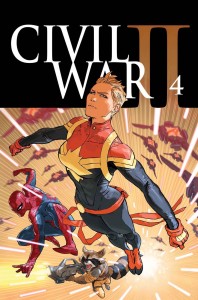 Civil War II #4 (of 7) — Writer: Brian Michael Bendis; Art: David Marquez; Colors: Justin Ponsor
Civil War II #4 (of 7) — Writer: Brian Michael Bendis; Art: David Marquez; Colors: Justin Ponsor
Captain Marvel #7 — Writers: Ruth Fletcher Gage and Christos Gage; Art: Marco Failla; Colors: Matt Wilson
Ms. Marvel #9 — Writer: G. Willow Wilson; Art: Takeshi Miyazawa and Adrian Alphona; Colors: Ian Herring
Totally Awesome Hulk #9 — Writer: Greg Pak; Art: Mike del Mundo; Colors: del Mundo and Marco D’Alfonso
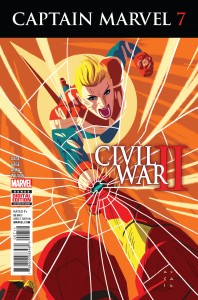 All four of these books are Civil War II-related, most significantly Civil War II #4 itself, the biggest draw, and as it rounds the halfway point of the big event it reveals more about how the Inhuman Ulysses’s future-forecasting power actually works, and deals with the aftermath of last issue’s killing. It’s mostly talking (shocking in a Bendis book, I know, although at least it’s good talking… and David Marquez continues to make everyone look good doing it), but ends on the verge of the major throwdown we’ve all been waiting for. Interesting that, although Tony
All four of these books are Civil War II-related, most significantly Civil War II #4 itself, the biggest draw, and as it rounds the halfway point of the big event it reveals more about how the Inhuman Ulysses’s future-forecasting power actually works, and deals with the aftermath of last issue’s killing. It’s mostly talking (shocking in a Bendis book, I know, although at least it’s good talking… and David Marquez continues to make everyone look good doing it), but ends on the verge of the major throwdown we’ve all been waiting for. Interesting that, although Tony 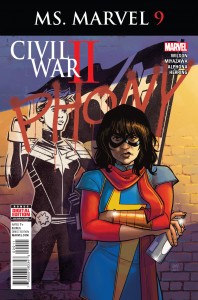 Stark was clearly on the wrong side in Civil War I, he’s got the better arguments this time out, and the obvious sympathies of Bendis (who throws around the word “profiling” a lot to describe what Captain Marvel and her side are doing). She’s portrayed a lot more sympathetically in her own book, though; Captain Marvel #9 this week has her justifying her crew’s proactive get-the-bad-guys-first stance with lots of examples of the good it’s done, and the lives it’s saved. Ms Marvel #9, on the other hand, outlines the other side’s arguments, as Kamala is heading a group of young heroes who, under Captain
Stark was clearly on the wrong side in Civil War I, he’s got the better arguments this time out, and the obvious sympathies of Bendis (who throws around the word “profiling” a lot to describe what Captain Marvel and her side are doing). She’s portrayed a lot more sympathetically in her own book, though; Captain Marvel #9 this week has her justifying her crew’s proactive get-the-bad-guys-first stance with lots of examples of the good it’s done, and the lives it’s saved. Ms Marvel #9, on the other hand, outlines the other side’s arguments, as Kamala is heading a group of young heroes who, under Captain 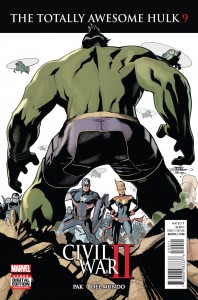 Marvel’s direction, take out potential threats, but begins to question the morality of it when one of the “threats” turns out to be someone she knows. It’s an even-handed look at a complex problem, made all the stronger because writer Wilson knows that Muslims like Kamala and her family get subjected to profiling all the time — but keeps that aspect subtle, instead of rubbing readers’ noses in it. Totally Awesome Hulk, of course, deals with the aftermath of the death in Civil War II #3, as Amadeus gets quizzed by an understandably-cautious superhero community, and responds both as himself and as his gamma-fueled alter ego. As with Civil War II, there’s more talk than action, but a last-page character arrival promises a lot more punching next issue, so readers will be sure to come back.
Marvel’s direction, take out potential threats, but begins to question the morality of it when one of the “threats” turns out to be someone she knows. It’s an even-handed look at a complex problem, made all the stronger because writer Wilson knows that Muslims like Kamala and her family get subjected to profiling all the time — but keeps that aspect subtle, instead of rubbing readers’ noses in it. Totally Awesome Hulk, of course, deals with the aftermath of the death in Civil War II #3, as Amadeus gets quizzed by an understandably-cautious superhero community, and responds both as himself and as his gamma-fueled alter ego. As with Civil War II, there’s more talk than action, but a last-page character arrival promises a lot more punching next issue, so readers will be sure to come back.
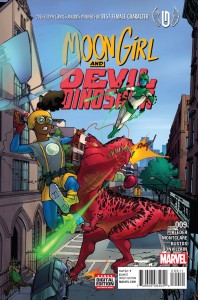 Moon Girl and Devil Dinosaur #9 — Writers: Brandon Montclare and Amy Reeder; Art: Natacha Bustos; Colors: Tamra Bonvillain
Moon Girl and Devil Dinosaur #9 — Writers: Brandon Montclare and Amy Reeder; Art: Natacha Bustos; Colors: Tamra Bonvillain
Unbeatable Squirrel Girl #10 — Writer: Ryan North; Pencils: Erica Henderson; Inks: Tom Fowler; Colors: Rico Renzi
Mighty Thor #9 — Writer: Jason Aaron; Art: Russell Dauterman; Colors: Matthew Wilson
All-New, All-Different Avengers #12 — Writer: Mark Waid; Art: Mahmud Asrar; Colors: Dave McCaig
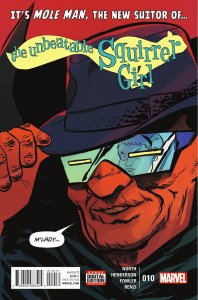 The rest of the Marvel books this week. If you haven’t picked up Moon Girl and Devil Dinosaur because the concept seems dumb or it stars a kid… get this issue. Notice the fast-moving story, the clear, attractive, action-oriented and often funny art, and the smart, stubborn and somehow adorable main characters (the description applies to both of them), and see if this book doesn’t charm you into becoming a regular reader. Now past its introductory phase, this book is hitting on all cylinders, and it would be a shame to miss it. Squirrel Girl is much the same; its main character is a twenty-something woman, but “smart, stubborn and adorable” applies to her just as well. Some older standard-superhero fans are put off by the cartoony art and the whip-quick, modern
The rest of the Marvel books this week. If you haven’t picked up Moon Girl and Devil Dinosaur because the concept seems dumb or it stars a kid… get this issue. Notice the fast-moving story, the clear, attractive, action-oriented and often funny art, and the smart, stubborn and somehow adorable main characters (the description applies to both of them), and see if this book doesn’t charm you into becoming a regular reader. Now past its introductory phase, this book is hitting on all cylinders, and it would be a shame to miss it. Squirrel Girl is much the same; its main character is a twenty-something woman, but “smart, stubborn and adorable” applies to her just as well. Some older standard-superhero fans are put off by the cartoony art and the whip-quick, modern 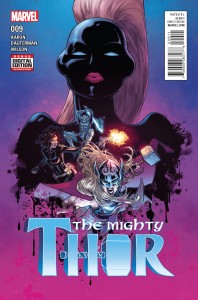 sensibilities, but this is the future of comics, attractive to Millennial fans and younger, and good for it: this issue, the conclusion of a tale about the Mole Man wanting to date our heroine, is brainy fun, combining Erica Henderson’s unusual, accomplished art with Ryan North’s clever asides and unexpected twists, and you owe it to yourself to check it out. Thor also stars an accessible, admirable woman, but it’s much more traditional-superhero, with Asgardian foes and evil industrialists and trolls and all the regular trappings; the reasons to buy it is (a) Dauterman’s art, because his layouts and pencils make the storytelling so clear and energetic, and (b) Aaron’s scripts, because he
sensibilities, but this is the future of comics, attractive to Millennial fans and younger, and good for it: this issue, the conclusion of a tale about the Mole Man wanting to date our heroine, is brainy fun, combining Erica Henderson’s unusual, accomplished art with Ryan North’s clever asides and unexpected twists, and you owe it to yourself to check it out. Thor also stars an accessible, admirable woman, but it’s much more traditional-superhero, with Asgardian foes and evil industrialists and trolls and all the regular trappings; the reasons to buy it is (a) Dauterman’s art, because his layouts and pencils make the storytelling so clear and energetic, and (b) Aaron’s scripts, because he  knows that Thor, whomever its main character, has always been about heroism in the face of long odds, and about battling through to victory; Kirby and Lee understood that, and this team does too. That leaves All-New, All-Different Avengers, another more-traditional superhero book, but done well: Waid and Asrar offer the conclusion of a three-parter about the Avengers in space versus Annihilus, and it’s got all the clever teamwork and character-building you’d expect from them (with special emphasis on the three kids: Nova, the younger Spider-Man, and Ms. Marvel); best of all, it has nothing to do with Civil War II, so if you’re looking for a break from the events in that series, it’s an entertaining refuge.
knows that Thor, whomever its main character, has always been about heroism in the face of long odds, and about battling through to victory; Kirby and Lee understood that, and this team does too. That leaves All-New, All-Different Avengers, another more-traditional superhero book, but done well: Waid and Asrar offer the conclusion of a three-parter about the Avengers in space versus Annihilus, and it’s got all the clever teamwork and character-building you’d expect from them (with special emphasis on the three kids: Nova, the younger Spider-Man, and Ms. Marvel); best of all, it has nothing to do with Civil War II, so if you’re looking for a break from the events in that series, it’s an entertaining refuge.
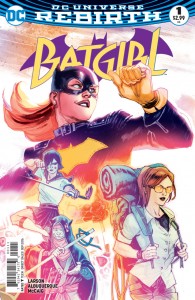 Batgirl #1 — Writer: Hope Larson; Art: Rafael Albuquerque; Colors: Dave McCaig
Batgirl #1 — Writer: Hope Larson; Art: Rafael Albuquerque; Colors: Dave McCaig
Hal Jordan and the Green Lantern Corps #1 — Writer: Robert Venditti; Pencils: Rafa Sandoval; Inks: Jordi Tarragona; Colors: Tomeu Morey
Nightwing #1 — Writer: Tim Seeley; Art: Javier Fernandez; Colors: Chris Sotomayor
Red Hood and the Outlaws: Rebirth #1 (of 1) — Writer: Scott Lobdell; Art: Dexter Soy; Colors: Veronica Gandini
Titans #1 — Writer: Dan Abnett; Pencils: Brett Booth;  Inks: Norm Rapmund; Colors: Andrew Dalhouse
Inks: Norm Rapmund; Colors: Andrew Dalhouse
Five DC books, all first issues (you’d think they were having a rebirth, or something…); Batgirl has a hard act to follow (its previous volume was another Millennials-and-younger-friendly, smart and shiny comic), but it begins with some good moves: in a solid break with the previous series, Barbara is out of Burnside and in Japan, meeting a new cast (including a groundbreaking Japanese heroine) and getting started on a quest to improve her skills. Albuquerque’s a wise choice for the artist, too; he provides a triangulation between the previous cartoonier, manga-ish style and more traditional superhero art, and it looks great: it won’t alienate the newer fans, and should attract the older ones too. All in all, it’s an effective beginning. Hal Jordan and the GLC engages  in some table-setting, too: with the Green Lanterns all seemingly wiped out, Sinestro and his fear-fueled, yellow-ringed crew are bringing their particularly rigid brand of order to the universe — but, of course, Jordan has something to say about that, and there’s a four-page coda at the end that helps to justify the “Corps” part of the title, too. None of this breaks any new ground, but it offers some clear antagonists and plotlines, and should be satisfying to fans who’ve been following previous incarnations of the Lantern characters. Nightwing is something of a return to basics, as Dick Grayson puts on the costume and takes up the name again, has talks with Batman and Batgirl, and goes about his current project of being a double-agent for the shadowy bad-guy organization, the Parliament of Owls. It’s standard but above-average Batman-type super-stuff, marred a little by the introduction of
in some table-setting, too: with the Green Lanterns all seemingly wiped out, Sinestro and his fear-fueled, yellow-ringed crew are bringing their particularly rigid brand of order to the universe — but, of course, Jordan has something to say about that, and there’s a four-page coda at the end that helps to justify the “Corps” part of the title, too. None of this breaks any new ground, but it offers some clear antagonists and plotlines, and should be satisfying to fans who’ve been following previous incarnations of the Lantern characters. Nightwing is something of a return to basics, as Dick Grayson puts on the costume and takes up the name again, has talks with Batman and Batgirl, and goes about his current project of being a double-agent for the shadowy bad-guy organization, the Parliament of Owls. It’s standard but above-average Batman-type super-stuff, marred a little by the introduction of 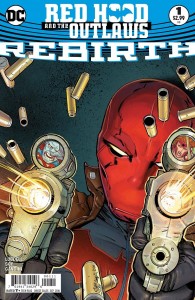 one of those bad guys whom the writer has to show is formidable by having him beat Grayson easily — but that might be a feint, so we’ll have to wait another issue to see. As with Hal Jordan, if you’ve been a fan of former versions of Nightwing, this should be a satisfying continuation. Red Hood and the Outlaws is a “Rebirth” one-shot, not a new-series first issue, so it’s all setup: a review of Jason Todd’s history with Batman, from their first meeting (when, as a kid, he tried to strip the Batmobile’s tires) to his “death” and current kind-of-bad good guy status; the “Outlaws” in the title only show up on the covers, so we’ll have to wait until the series debut to find out how Bizarro(!) and generic-chick-with-sword (I had to look it up; I was guessing Katana, but it’s actually Artemis, the rogue Amazonian frenemy of Wonder Woman) figure into his plans to infiltrate and wipe out Gotham’s criminal element. Same writer as always, with OK-but-generic art, so it’s
one of those bad guys whom the writer has to show is formidable by having him beat Grayson easily — but that might be a feint, so we’ll have to wait another issue to see. As with Hal Jordan, if you’ve been a fan of former versions of Nightwing, this should be a satisfying continuation. Red Hood and the Outlaws is a “Rebirth” one-shot, not a new-series first issue, so it’s all setup: a review of Jason Todd’s history with Batman, from their first meeting (when, as a kid, he tried to strip the Batmobile’s tires) to his “death” and current kind-of-bad good guy status; the “Outlaws” in the title only show up on the covers, so we’ll have to wait until the series debut to find out how Bizarro(!) and generic-chick-with-sword (I had to look it up; I was guessing Katana, but it’s actually Artemis, the rogue Amazonian frenemy of Wonder Woman) figure into his plans to infiltrate and wipe out Gotham’s criminal element. Same writer as always, with OK-but-generic art, so it’s 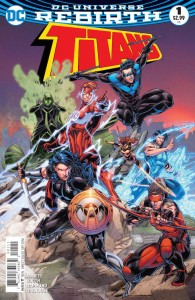 probably going to be exactly what you think it is (my interest level is low, but if alternate-cover artist Bengal was drawing the book, I’d pick it up in a heartbeat). Titans #1 continues to be the new DC title most closely tied to the “Rebirth” mega-story, as it focuses on Wally West, who gets a new costume and starts rounding up the old Titans gang to find out how they lost ten years of their lives; it also features the return of a major Rogue’s Gallery villain (one of the most powerful, and who hasn’t been seen in a while), who may or may not be closely connected to the whole timeline-alteration thing. If you’re interested in the current DC backstory/ongoing universal developments, this is the book to buy.
probably going to be exactly what you think it is (my interest level is low, but if alternate-cover artist Bengal was drawing the book, I’d pick it up in a heartbeat). Titans #1 continues to be the new DC title most closely tied to the “Rebirth” mega-story, as it focuses on Wally West, who gets a new costume and starts rounding up the old Titans gang to find out how they lost ten years of their lives; it also features the return of a major Rogue’s Gallery villain (one of the most powerful, and who hasn’t been seen in a while), who may or may not be closely connected to the whole timeline-alteration thing. If you’re interested in the current DC backstory/ongoing universal developments, this is the book to buy.
 Rom #1 — Plot/Script: Christos Gage and Chris Ryall; Pencils/Colors: David Messina; Inks: Michele Pasta
Rom #1 — Plot/Script: Christos Gage and Chris Ryall; Pencils/Colors: David Messina; Inks: Michele Pasta
Predator Vs. Judge Dredd Vs. Aliens #1 — Writer: John Layman; Art: Chris Mooneyham; Colors: Michael Atiyeh
Archie #10 — Writer: Mark Waid; Art: Veronica Fish; Colors: Andre Szymanowicz with Jen Vaughn
Autumnlands #12 — Writer: Kurt Busiek; Art: Benjamin Dewey; Colors: Jordie Bellaire
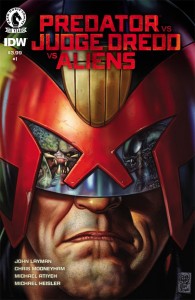 Future Quest #3 — Writer: Jeff Parker; Art: Steve Rude; Colors: Steve Buccellato
Future Quest #3 — Writer: Jeff Parker; Art: Steve Rude; Colors: Steve Buccellato
Jem and the Holograms #17 — Writer: Kelly Thompson; Art: Jen Bartel; Colors: M. Victoria Robado
Jupiter’s Legacy 2 #2 — Writer: Mark Millar; Art: Frank Quitely; Colors: Sunny Gho
Outcast #19 — Writer: Robert Kirkman; Art: Paul Azeceta; 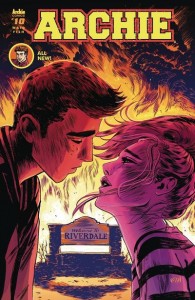 Colors: Elizabeth Breitweiser
Colors: Elizabeth Breitweiser
Rick and Morty #16 — Writer: Kyle Starks; Art: C.J. Cannon; Colors: Ryan Hill
All the week’s indy titles (at least, the ones that caught my eye, and my wallet): Rom is the return of the ’80s character, a toy-line tie-in figure first published by Marvel, and suffers a little because it lacks the Sal Buscema art, so house-style-perfect and clear, that was a big part of the attraction of the original; it also lacks the Bill Mantlo  scripts, because Mantlo was a master at pitching comics to that eight-to-twelve-year-old sweet spot when comics fans first get hooked. However, the book name-checks both creators on the letters page (and provides a link to donate to Mantlo’s long-term care, since he was seriously brain-damaged in an accident a couple of decades ago), so it gets points for crediting its origins. The concept — shape-shifting aliens have gradually taken over the planet, and only the space-knight Rom’s analyzer ray can reveal them — is rock-solid (and has been since… what, Invasion of the Body Snatchers?), so this has a decent foundation to build
scripts, because Mantlo was a master at pitching comics to that eight-to-twelve-year-old sweet spot when comics fans first get hooked. However, the book name-checks both creators on the letters page (and provides a link to donate to Mantlo’s long-term care, since he was seriously brain-damaged in an accident a couple of decades ago), so it gets points for crediting its origins. The concept — shape-shifting aliens have gradually taken over the planet, and only the space-knight Rom’s analyzer ray can reveal them — is rock-solid (and has been since… what, Invasion of the Body Snatchers?), so this has a decent foundation to build 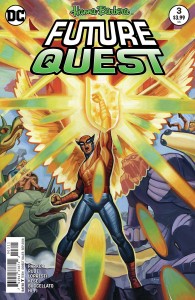 on. Predator Vs Judge Dredd Vs Aliens pretty much tells you everything you need to know about it in its title; it only remains to note that writer Layman has scripted a lot of Dredd stories before, and knows the character well, and that this reads like a typically-gonzo 2,000 AD serial, but with the advantage of a bigger page count. Archie continues its updating of the iconic teen, with Mark Waid bringing a continued-serial format to the plots that they’ve never had; he and Fish deliver a compelling package, enhanced by the inclusion of a classic Archie short in each issue (this one was written by the masterful and
on. Predator Vs Judge Dredd Vs Aliens pretty much tells you everything you need to know about it in its title; it only remains to note that writer Layman has scripted a lot of Dredd stories before, and knows the character well, and that this reads like a typically-gonzo 2,000 AD serial, but with the advantage of a bigger page count. Archie continues its updating of the iconic teen, with Mark Waid bringing a continued-serial format to the plots that they’ve never had; he and Fish deliver a compelling package, enhanced by the inclusion of a classic Archie short in each issue (this one was written by the masterful and 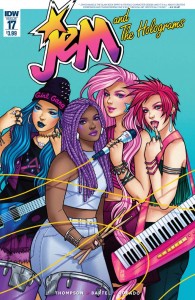 longtime Riverdale chronicler Frank Doyle, and Waid provides a passionate and informative tutorial on him in the letters page). Autumnlands continues Busiek and Dewey’s anthropomorphic/sword and sorcery epic; Busiek’s very good at dropping hints about how our world turned into this one, and Dewey draws humanized animals better than anyone. There are a lot of nice character touches here, from the loyal dogs to the wise owls to the old goat that, in this issue, acts exactly like an old goat, and gets into considerable trouble for it; this series’s trade collections should be good sellers for a long time. Future
longtime Riverdale chronicler Frank Doyle, and Waid provides a passionate and informative tutorial on him in the letters page). Autumnlands continues Busiek and Dewey’s anthropomorphic/sword and sorcery epic; Busiek’s very good at dropping hints about how our world turned into this one, and Dewey draws humanized animals better than anyone. There are a lot of nice character touches here, from the loyal dogs to the wise owls to the old goat that, in this issue, acts exactly like an old goat, and gets into considerable trouble for it; this series’s trade collections should be good sellers for a long time. Future  Quest continues to attract attention — at least, from readers of a certain age — because of its mashup of classic Hanna Barbera adventure cartoons. In this issue, there’s the added incentive of an eleven-page Birdman story by the amazing Steve Rude, plus a back-up tie-in tale involving the Herculoids, with art by Aaron Lopresti; DC’s batting .500 with their cartoon updates, with this and Scooby Doo Apocalypse being readable and fun, while The Flintstones and Wacky Races so far are just… well, not so much. Jem and the Holograms continues to be fun, too, a modern updating of that ’80s cartoon; having just finished a long
Quest continues to attract attention — at least, from readers of a certain age — because of its mashup of classic Hanna Barbera adventure cartoons. In this issue, there’s the added incentive of an eleven-page Birdman story by the amazing Steve Rude, plus a back-up tie-in tale involving the Herculoids, with art by Aaron Lopresti; DC’s batting .500 with their cartoon updates, with this and Scooby Doo Apocalypse being readable and fun, while The Flintstones and Wacky Races so far are just… well, not so much. Jem and the Holograms continues to be fun, too, a modern updating of that ’80s cartoon; having just finished a long 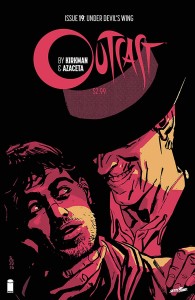 “Dark Jem” arc last issue, this one concentrates on the fallout, and revs up some of the regular soap-opera-ish subplots and rivalries that writer Thompson has proven adept at keeping interesting and human; add in the brightly-colored, high-fashion art by Bartel, and this is a great comic for an audience that wouldn’t necessarily like the standard superhero fare. Jupiter’s Legacy is standard superhero fare, but done very well; if you want beautiful, otherworldly-looking people performing various super-feats and acting horribly and violently with each other, Quitely’s your guy, and Millar knows just how to play to his
“Dark Jem” arc last issue, this one concentrates on the fallout, and revs up some of the regular soap-opera-ish subplots and rivalries that writer Thompson has proven adept at keeping interesting and human; add in the brightly-colored, high-fashion art by Bartel, and this is a great comic for an audience that wouldn’t necessarily like the standard superhero fare. Jupiter’s Legacy is standard superhero fare, but done very well; if you want beautiful, otherworldly-looking people performing various super-feats and acting horribly and violently with each other, Quitely’s your guy, and Millar knows just how to play to his  strengths. Outcast finds its hero captured by the bad guys, and so is an info-dump issue, as we find out quite a bit about how Kyle’s powers work, and why the demons possessing humans both need him and are afraid of him; Azeceta’s art makes even the quiet conversations here dark and menacing. That leaves Rick and Morty, which begins a new story and is as universe-hoppingly weird and cynically funny as ever, with sister Summer getting a chance to share some of the spotlight with drunken mad-scientist Rick and perpetually-put-upon grandson Morty. Whether you’ve ever seen the cartoon it’s based on or not, this is a book for happily-disturbed minds; pick it up to see if you qualify.
strengths. Outcast finds its hero captured by the bad guys, and so is an info-dump issue, as we find out quite a bit about how Kyle’s powers work, and why the demons possessing humans both need him and are afraid of him; Azeceta’s art makes even the quiet conversations here dark and menacing. That leaves Rick and Morty, which begins a new story and is as universe-hoppingly weird and cynically funny as ever, with sister Summer getting a chance to share some of the spotlight with drunken mad-scientist Rick and perpetually-put-upon grandson Morty. Whether you’ve ever seen the cartoon it’s based on or not, this is a book for happily-disturbed minds; pick it up to see if you qualify.



